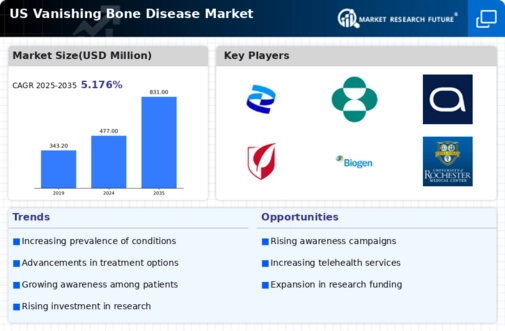Advancements in Diagnostic Technologies
Technological advancements in diagnostic tools are significantly impacting the vanishing bone-disease market. Enhanced imaging techniques, such as high-resolution MRI and CT scans, allow for earlier and more accurate diagnosis of bone disorders. This improved diagnostic capability is crucial, as timely identification of vanishing bone disease can lead to better patient outcomes and more effective treatment plans. The market for diagnostic technologies is projected to grow, with estimates indicating a CAGR of around 8% over the next few years. As healthcare providers adopt these advanced diagnostic methods, the demand for subsequent therapeutic interventions is likely to rise, thereby driving the overall growth of the vanishing bone-disease market. The integration of artificial intelligence in diagnostics may also streamline the identification process, further enhancing market dynamics.
Rising Incidence of Rare Bone Disorders
The increasing prevalence of rare bone disorders, including vanishing bone disease, is a critical driver for the vanishing bone-disease market. Recent estimates suggest that approximately 1 in 100,000 individuals may be affected by this condition in the US. This rising incidence necessitates the development of targeted therapies and treatment options, thereby stimulating market growth. As healthcare providers become more aware of these disorders, the demand for specialized treatments is likely to increase. Furthermore, the growing patient population may lead to enhanced research funding and investment in innovative therapies, which could further propel the vanishing bone-disease market. The need for effective management strategies for these rare conditions is becoming increasingly apparent, indicating a robust market potential for stakeholders involved in the development of therapeutic solutions.
Regulatory Incentives for Drug Development
Regulatory incentives provided by government agencies are significantly influencing the vanishing bone-disease market. Programs such as orphan drug designation and fast-track approval processes encourage pharmaceutical companies to develop treatments for rare diseases. These incentives can reduce the time and cost associated with bringing new therapies to market, making it more appealing for companies to invest in the development of treatments for vanishing bone disease. The potential for market exclusivity and financial benefits associated with these regulatory pathways may lead to an increase in the number of clinical trials and new drug applications. As a result, the overall landscape of the vanishing bone-disease market is likely to evolve, with more innovative therapies becoming available to patients in the near future.
Growing Patient Advocacy and Support Groups
The emergence of patient advocacy and support groups is playing a vital role in the vanishing bone-disease market. These organizations raise awareness about rare bone disorders and provide essential resources for affected individuals and their families. By advocating for better treatment options and increased funding for research, these groups are influencing public policy and healthcare practices. Their efforts have led to heightened visibility of vanishing bone disease, which may result in increased patient enrollment in clinical trials and studies. As more patients become engaged and informed, the demand for effective therapies is likely to rise, thereby driving market growth. The collaboration between advocacy groups and pharmaceutical companies can also facilitate the development of tailored treatment solutions, further enhancing the market landscape.
Increased Research Funding for Rare Diseases
The surge in research funding for rare diseases is a pivotal driver for the vanishing bone-disease market. Government initiatives and private sector investments are increasingly directed towards understanding and treating rare bone disorders. In recent years, funding for research in this area has seen a notable increase, with federal allocations reaching approximately $500 million annually. This financial support fosters innovation and encourages pharmaceutical companies to invest in the development of new therapies. As research progresses, the potential for breakthroughs in treatment options becomes more pronounced, which could significantly enhance the therapeutic landscape for vanishing bone disease. The growing emphasis on rare disease research not only benefits patients but also creates a favorable environment for market expansion.
























Leave a Comment